
When it comes to Filipino Food, I always enjoy championing it and in the process, I hope it encourages people to give it at try. On that note, I thought I'd do another post about Magic Wok, a Filipino restaurant in Artesia. This is actually my second time blogging about Magic Wok. Click here to read about my very first experience dining there. At Magic Wok, I went with a group of friends and we shared 12 dishes and compared to previous restaurants I've been to, I feel that Magic Wok is the closest to restaurant home-style Filipino Cooking that I've experienced.
Simply, it's because there's no fuss or muss about the food. There are no fusion flavors in play or interpretations of Filipino cooking. The dishes aren't made to look pretty or served in fancy dishes. That's not to say that the way the dishes are prepared here represent all of Filipino cooking. Like any other country, dishes can differ on a regional basis, but basically, what you see is what you get at Magic Wok.
Our meal started with Sisig. In the Philippines, traditional sisig is usually cooked with the pig head and may include parts of the face, ears, brains as well as other left over parts of the pig. My experience with sisig here has been varied. I've had it as a sizzling dish with crispy pork meat and chock-full of chicharon (pork rind) bits and also as a sauteed dish of marinated pork cheeks. The version at Magic Wok utilized fried pork with skin cooked with carrots and scallions, seasoned with garlic, black pepper and citrus. It was actually one of the favorite dishes of the night.

Following the sisig came the Fried Bangus. Bangus is a milkfish that is a popular fish in Filipino Cuisine and is known for its many tiny little bones, so always proceed with caution when eating it. Fried bangus is first marinated in vinegar, pepper, garlic, lemon or calamansi juice and sometimes soy sauce before being pan-fried to a golden goodness. The lovely thing about this bangus is that the fried fish skin also absorbs the tangy flavors of the marinade, so it's tasty from the inside-out.
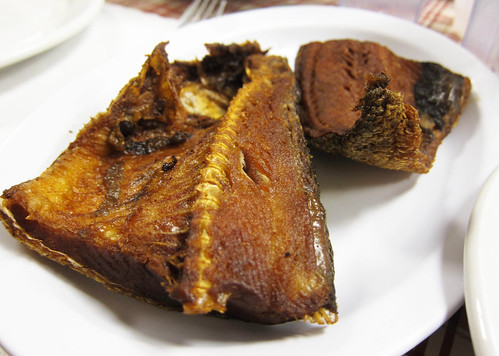
Soon, the Sinigang hit the table. Sinigang is a tamarind-based sour soup that usually includes vegetables like white radishes, napa cabbage and green beans and can be with or without a protein. We ordered two versions, one with shrimp and one with salmon. Other than Jeepney Asian Grill, Magic Wok is the only other place that I've had this soup that included green chile as an ingredient. The kick of heat went well with the sour notes from the tamarind.
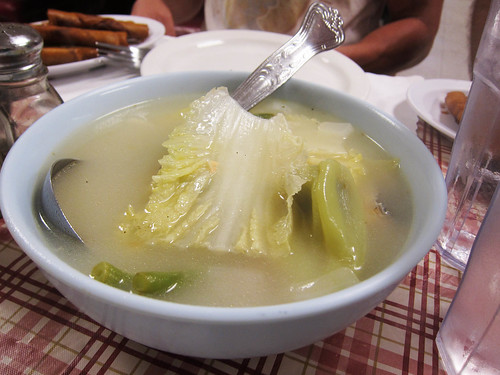
Next was the Beef Tapa. Like the Fried Bangus, the beef for this dish is marinated in vinegar, pepper, garlic, black pepper and salt. The differences between the two is that the soy sauce may be an option for the Fried Bangus, but not for the Beef Tapa. Also, sugar is added to the Beef Tapa recipe, but not to the Fried Bangus recipe. Once marinated, the beef is then fried and is usually more chewy than tender. That's how it's usually meant to be and that's we got that night.
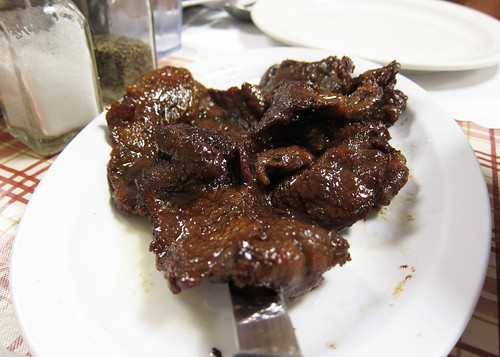
Of course, it's hard not to have a Filipino meal without lumpia and the ones at Magic Wok were wonderfully crispy and by the way, are great dipped in vinegar before biting into it.
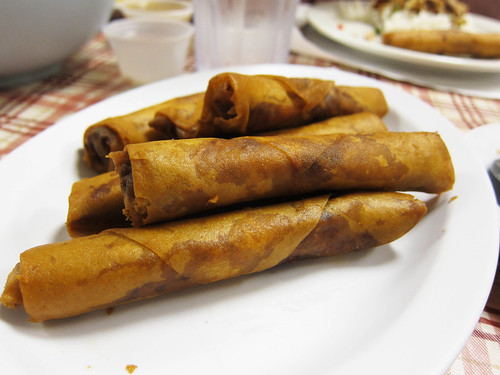
Our one noodle dish was their Pansit Palabok (sometimes referred to as Pansit Malabon). Although I liked that the noodles were al dente, this Pansit Palabok version wasn't one of my favorites. It just didn't have a lot of flavor. The sauce that usually comes with this dish is made up of shrimp juice and atchuete oil, which is then thickened by flour. That shrimpy flavor of that sauce was MIA plus there's usually more toppings to mix into your noodles. The sliced boiled eggs and green onions were an after thought and crunchy pork skin was just plain missing. The only saving grace was the squeeze of lemon which added a nice zest of tartness to the noodles.
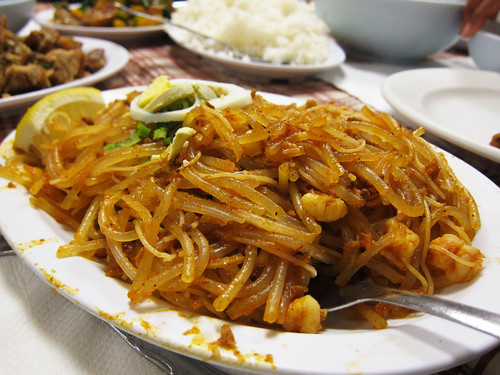
Following the disappointing Pansit Palabok came the Pinakbet, which seemingly could be a vegetarian dish, if it wasn't for the fact that it's cooked with a pungent shrimp paste aka bagoong. The vegetables included in this dish were eggplant, green beans, squash, okra and bitter melon. Pinakbet is definitely not for everyone just because of that shrimp paste. It has a strong smell and an equally strong taste that is salty and even a bit briny. While the vegetables were cooked well, there just wasn't enough shrimp paste in this dish to my liking. So next time, they need to pour it on.
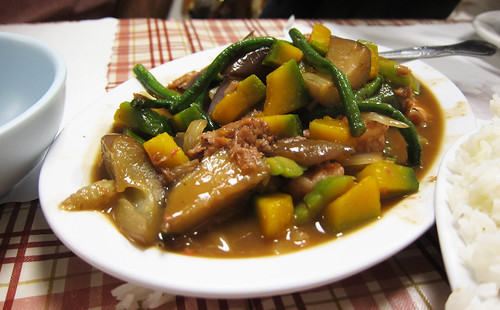
Next was Chicken Adobo. Chicken Adobo is interesting in that it's one of the more well-known dishes in Filipino Cuisine, but even with such few ingredients, everyone has their own opinion on what the proper way is to cook it. Simply, the basic recipe for chicken adobo is chicken that is simmered in a mixture of vinegar, soy sauce, garlic, black pepper corns and a bay leaf. There are of course variations where the chicken is fried and then added back to the liquid and served. That's how my Mom does it. Some people prefer more vinegar and others more soy sauce. To one cook, one bay leaf is enough. To another, two is necessary.
The flavor of that sauce is pretty important because it's something we pour over our rice and eat along with the chicken. I actually thought the adobo sauce had a nice balance between the vinegar and soy sauce. I was happy to pour it over my rice and eat it. However, I prefer a chicken that's fried as opposed to stewed. Also, the chicken pieces were on the bony side, so there wasn't much meat to be had.
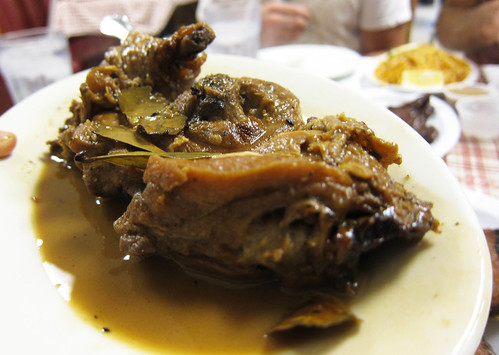
Ampalaya aka Bitter Melon with Pork arrived next. Bitter melon literally can be a bitter pill to swallow, let alone chew. For many, this vegetable is an acquired taste. I grew up with my Mom "treating" it to remove some of the bitterness of this veggie, but even then, it could still be too much to handle for most. This particular bitter melon actually wasn't as bitter as it could have been (at least for me) and I enjoyed the dish. Overall, I did think it needed a bit more seasoning. A little more salt and/or pepper, perhaps.
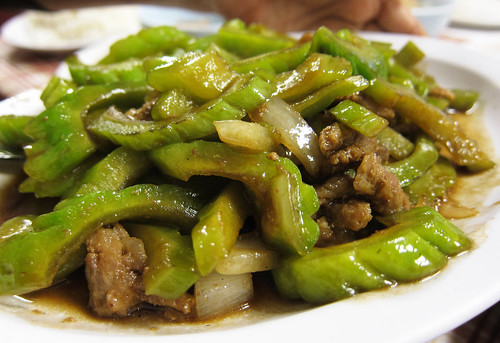
Then there's the Crispy Pata, which is basically a pig knuckle that is deep fried. I can't go to any Filipino restaurant without ordering this dish. More than the meat itself, it's about the fried pig skin dipped in a vinegar mixture of garlic and black pepper that does it for me. Sometimes too much of a good thing isn't good. That night, the whole pig knuckle was fried for so long that the meat underneath the skin was too dried out and didn't have the fatty tenderness it usually has. Unfortunately, the Crispy Pata wasn't the shining star it usually is.

While the Pinakbet didn't have enough shrimp paste, the Binagoongang Baboy dish had it in spades. Considering the translation for Binagoongang Baboy is Pork with Shrimp Paste, that wasn't surprising. The shrimpy, salty, briny taste was definitely there. My disappointment was in the pork itself, which was very fatty. In fact, there were more cubes of fat than actual meat in that bowl then there should have been. Now if that fat were deep fried, that would have been okay, but that just wasn't the case.

11 dishes down and now it was time for dessert and shared 2 Halo Halos. One was topped with mango ice cream and the other with ube ice cream. Halo Halo translates to Mix Mix because it's a mix of shaved ice, milk and a variety of ingredients that can include anything from sweetened beans and fruit to kidney beans and garbanzo beans and even corn and plantains.
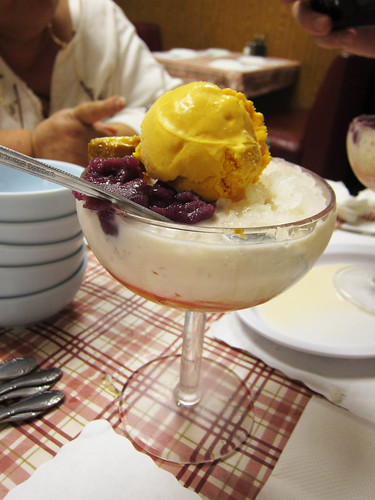
There's really no standard recipe for Halo Halo. It varies from restaurant to restaurant and for someone making it home, it's very customizable. The Magic Wok versions had the ice cream as well as leche plan (a Filipino version of flan), ube halaya and a variety of sweetened beans and jellies.
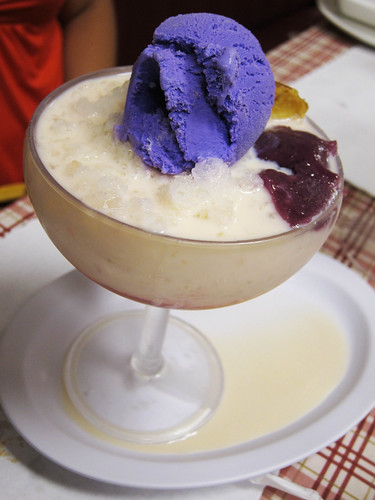
Overall, Magic Wok is still one of my favorite Filipino restaurants in LA. It's definitely a hole-in-the wall restaurant where the service can be a bit slow and the wait a bit long, especially during the weekend. However, for straight forward Filipino Cooking, Magic Wok should make it on your list of must try Filipino restaurants.
Magic Wok
11869 Artesia Blvd
Artesia, CA 90701
(562) 865-7340
If you’d like to read more about my tasty travels around town, click here or if you’d like to join my dining group, Pleasure Palate, click here!







